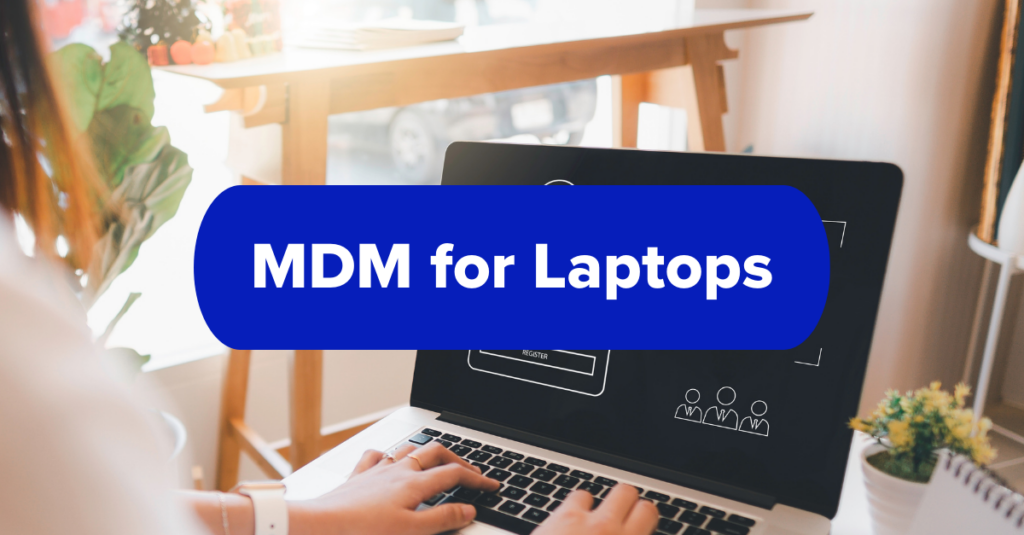In a perfect world, your employees are happily using their personal devices for work, easily toggling back and forth between their personal and professional lives. There’s no juggling between a work-only device and personal devices. Life is good. This is where Mobile Device Management (MDM) methods come into play.
MDM software allows IT departments to manage, secure, and monitor mobile devices like phones and tablets that employees use for company tasks. MDM features containerization that separates corporate and personal data on a mobile device. An encrypted container holds work-related data and apps, keeping it secure and separate from the user’s personal information. It can manage corporate applications and ensures devices are compliant with corporate policy It also allows IT teams to remotely wipe or lock devices if they are lost or stolen.
Essentially, mobile device management lets employees seamlessly go between Instagram videos and client emails while keeping company data secure. With remote work and BYOD (Bring Your Own Device) becoming the norm, MDM is essential to keep everything running smoothly without requiring your IT team to constantly be on edge, scanning for cyber-attacks and malware.
It sounds ideal, but can it also work for BYOD laptops?
To answer that, we must first understand how MDM changed the game for mobile devices in the workplace.
How MDM Changed the Use of Mobile Devices and Liberated Organizations
MDM changed the game. All of a sudden, companies had a way to embrace BYOD, saving them from having to buy and sometimes ship work-only mobile phones to each employee. This flexibility not only slashed operating expenses but freed up funds for other priorities (like better research or a new espresso machine). MDM also made it easier to install, update, and remove apps and policies across various devices, so everyone from the new intern to the seasoned execs had a secure, consistent mobile experience. However, with all of its benefits, security confines like MDM can sometimes bring privacy concerns along with them.
The Privacy Paradox – Benefits for Employers, Privacy Concerns for Workers
The privacy paradox in MDM refers to the tension between securing company data while respecting employee privacy. On one hand, employers must protect sensitive information and ensure compliance with security protocols. On the other hand, almost all employees worry about their privacy and are concerned that security tools like MDM might be tracking their private activities. It is true that the software monitors activities for security reasons, such as app usage, location, and browsing history. However, employee concerns can often be mitigated with clear communication about what exactly is being monitored and why. When companies don’t explain these details through a clear and consistent BYOD policy, employees will sometimes assume that all their personal data and activities are being watched.
The Role of Containers in MDM
Before containerization, MDM tended to peek into almost every corner of personal devices. This led to a lot of pushback and concern from employees and contractors. Enter containers, a software construct that can restrict MDM’s reach to only business-related data, allowing employees to keep their personal activities off limits.
Within MDM, the container represents a secure, isolated environment that separates work data and applications from personal ones on a device. It keeps corporate data protected and manageable without interfering with personal data and usage. This helps address the privacy paradox by allowing IT to enforce security policies and monitor corporate data and apps, while ensuring employees’ personal information and activities remain private. But is this enough to make employees trust that personal data stays private? How will they know what is or is not being tracked?
There are Two Sides to Every Story
From the employer’s perspective, they want IT to ensure that any device accessing the company’s network is secure, has been updated with the latest patches, and is free of malware. Without MDM, the manager has to trust employees to handle this themselves, and ‘hope’ they don’t leave any security gaps open. MDM for laptops lets the IT team manage these tasks centrally, reducing the risk of human error and potential data breaches.
Now, consider an employee working from home on their personal device. They need to know their privacy is respected and not worry that MDM will be monitoring their personal activities, like browsing habits or app usage. This creates tension, especially when employees can’t be sure of what is being monitored and what isn’t.
Best Practices for Transparent Communication and Gaining Employee Buy-In
- Policy Implementation: Develop policies that respect privacy while maintaining security. For example, make sure the monitoring is limited to work-related applications and have access control rules that prevent organizational data from being copied or shared outside the apps.
- Transparent Communication: Make it a point to be upfront and clear about which data is being monitored and why. It makes sense to schedule Q&A sessions so you can address people’s concerns and demystify the process. It would be ideal if employees could have a visual indication for each app being monitored so they can be relaxed about what is and isn’t kept private.
- Employee Education: Educate employees about the different security policies and encourage them to be more knowledgeable on what keeps data secure. Share success stories of how MDM for laptops can prevent breaches and ask for their input. A collaborative approach can lead to better awareness and acceptance of effective policies.
- Use a Solution that’s Easy to Implement and Doesn’t Affect Productivity: Find a solution that is easy to install and doesn’t slow employees down when they’re working on company apps and data. If employees find themselves constantly running to IT to get help with configurations, or suffering slowdowns, they won’t be able to focus on their work tasks. And no company needs an overloaded IT team.
What about MDM for Laptops?
Imagine applying the same containerization tech from mobile devices to BYOD laptops or unmanaged computers. Instead of IT having access to everything on a personal device, they would only manage a secure container for business use, leaving the rest of the device untouched. This approach could ensure corporate security while respecting personal privacy—nurturing a flexible, productive and trusting remote work environment. That’s exactly what Venn has done.
Venn is shaking up the MDM for laptops game by applying a similar containerization capability that combines robust security with respect for employee privacy on any PC or Mac. With Venn, IT can securely manage corporate data, applications and the network within a contained environment on personal devices, leaving personal data and activity untouched. This supports BYOD policies, boosts employee satisfaction, and ensures compliance with security protocols.
Venn took a very different approach creating a Secure Enclave to protect work on any unmanaged laptop. Its patented Blue Border software puts a virtual wrapper around work applications and data. Work applications run locally within the enclave – visually indicated by a blue border – where business activity is isolated and protected from any personal user on the same computer.
Security policies can be specifically applied to any individual user or a group of users. They can include the ability to restrict or enable moving data, printing, clipboard copy/paste, screen sharing, uploads, and more. Narrowing company control to only within Blue Border’s Secure Enclave fundamentally simplifies the scope and cost of securely onboarding remote workers or contractors who want or need to use their own PC or Mac. It’s simple to use, cost-effective, and easy to support. Venn ensures security and complies with regulatory requirements, and companies can onboard and offboard remote workers in minutes.
Security and compliance-driven companies gain protection for what counts and employees enjoy more freedom, flexibility, and privacy. Freedom without compromise.
Ready to revolutionize your device management strategy? Download our comprehensive eBook on, “The Next Step in BYOD Security: MDM for Laptops,” and discover best practices, real-world examples, and detailed insights into balancing security with employee trust.



